Everest Base Camp Trek
- 14 Breakfast
- 11 Lunch
- 11 Dinner
- Hotel in Kathmandu
- Lodges in Trek
- Trekking
- Sightseeing
- Scenic Flight


The Everest Base Camp Trek embodies humanity’s relentless drive, drawing women and men towards the towering presence of the Earth’s highest mountain. More than just trekking, it takes you deep into the Himalayas, to places where people gaze at beautiful landscapes as they try to be part of Sherpas and get humbled before Mt. Everest.
The path used by those who walk through it happens to be a winding footbridge across fast-flowing river glaciers over this thrilling suspension below described vivid details about villages around Sherpa communities who have an opportunity to observe history made through colorful prayer flags found in old monasteries and even research into cultures struck elsewhere found among these interesting new settlements scattered along sides of peaks amidst darkness engulfs.
Thousands of people watch approaching oncoming doors with arms open wide, ready for service, like workers seeking refuge with thoughts intertwined with love for their surroundings. At the same time, they move here every season just because gods forged them from the Earth so long ago. Everest base camp trek symbolizes one pilgrimage that everybody labors toward since it has everything: a personal trek yardstick for cross‐cultural understanding, the relationship between man and nature, etc.
The Everest base camp trek would change your life because this is how it affects you: through self-discovery, testing one’s body, and experiencing the pristine nature of the Himalayas. When one has this trek, it will alter it for them all together, be they expert hikers or those who want a similar experience.
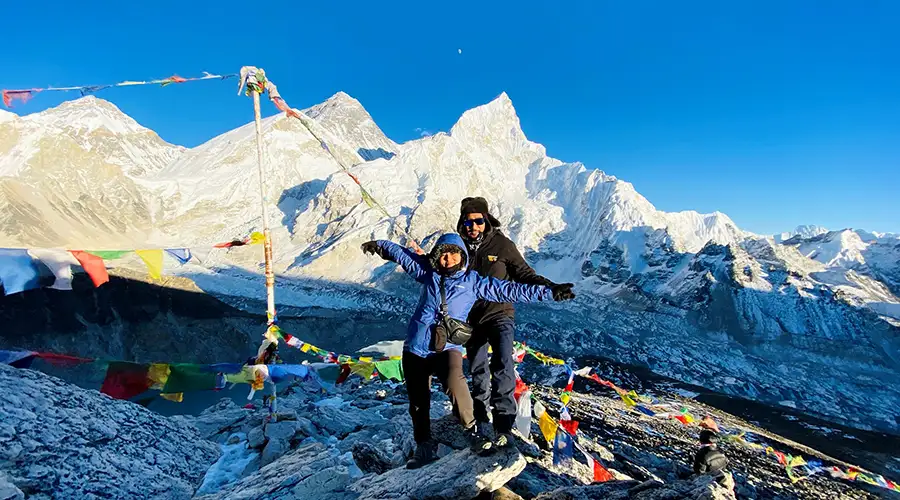
Kala Patthar - Mount Everest in the background
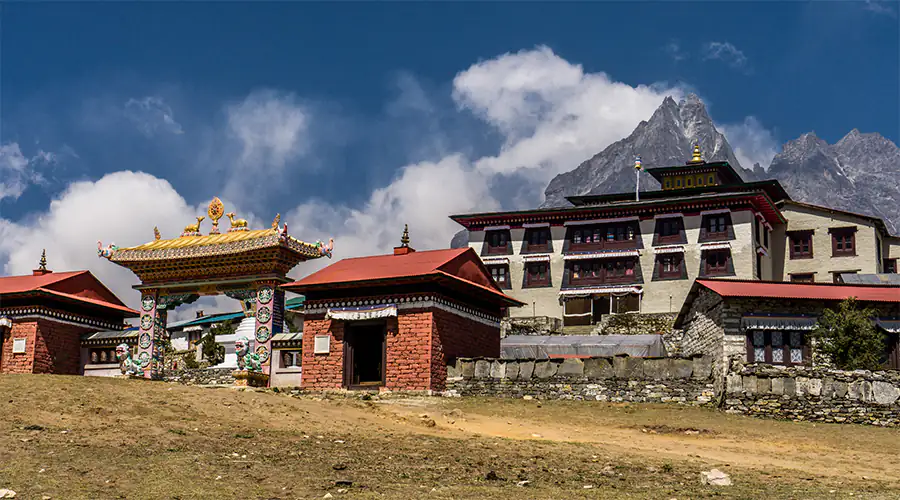
Tengboche Monastery
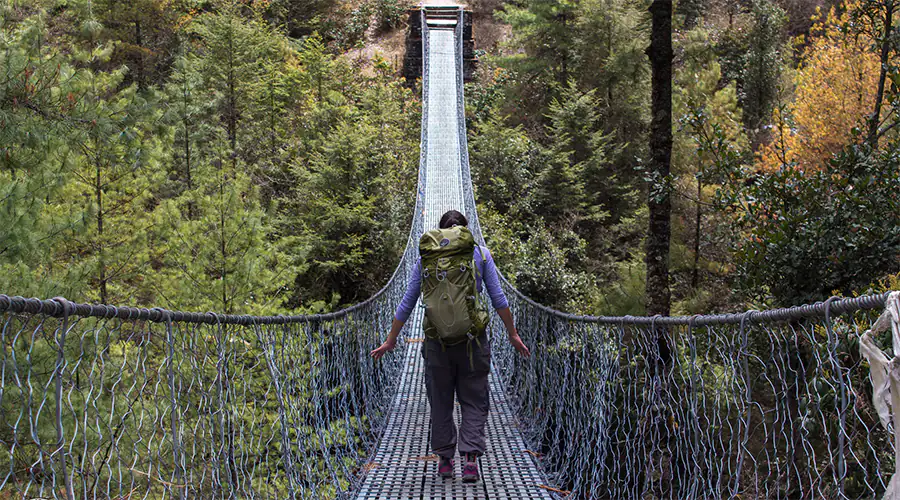
Crossing suspension bridge
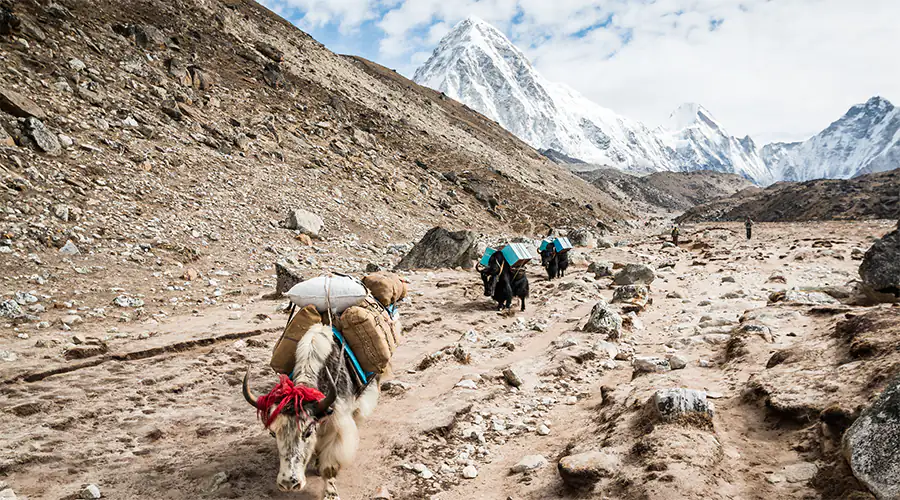
Jhopke - Used for transportation
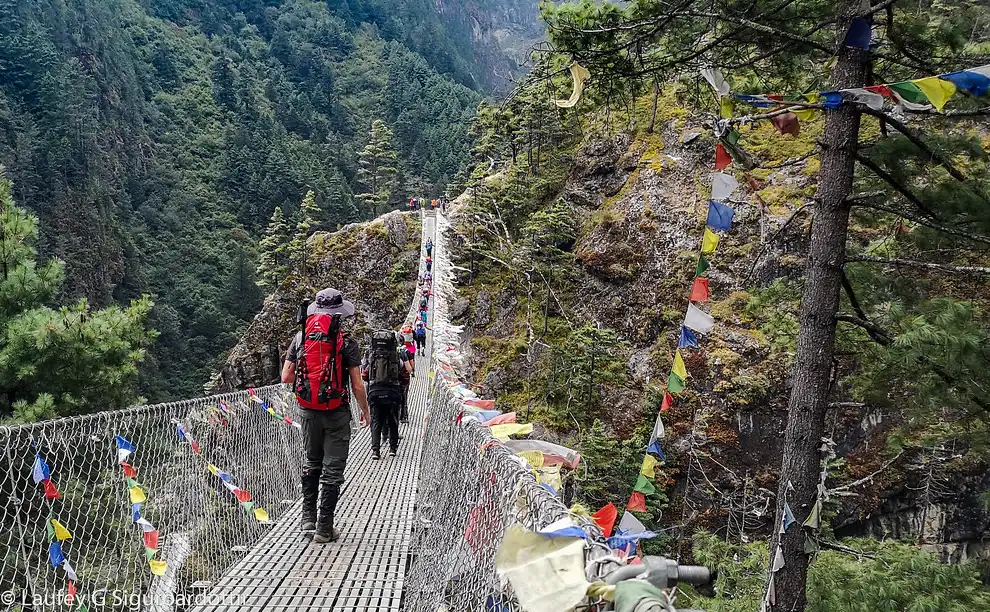
Trekkers make their way across the iconic Hillary Bridge, draped in prayer flags, on the trail from Phakding to Namche Bazaar.
Altitude: 1,350m/4,428ft
Hello and greetings from Kathmandu, the colorful capital of Nepal, deeply rooted in its history and tradition. If it is a clear day and you step off the plane, the snow-capped Himalayan mountains greet you, and it’s like an overture to your base camp trekking.
Once you go through the customs procedures, someone will be waiting for you in the arrival lounge on behalf of Peregrine Treks and Tours. They will then take you to a comfortable hotel. Spare some time to relax after traveling.
A few hours later, your well-informed Peregrine guide will meet with you for a brief trekking briefing before dawn. They will say much about the Everest base camp trekking adventure, including itineraries, tips on what to carry, and reasonable things along each trail. It is an excellent opportunity to inquire about holidays in high-altitude zones to glimpse what is there before you begin.
Accommodation: The Everest Hotel
Meals: Not Included
Altitude: 2,800m/9184ft (Lukla) & 2,652m/8,698ft (Phakding) Walking Distance: Approx 8km (3-4 hours) – Flight time: 35 min
Your guide will escort you to the airport for a short morning flight Lukla – often referred to by many as the gateway to the Everest region. You will be rewarded with magnificent views of towering mountains during the flight. Feel the adventure when your aircraft land at the Lukla airstrip. You will be introduced to your porter at Lukla, who will accompany you for the rest of the trek.
The trek begins with a leisurely walk through the Chaurikharka village and descent towards Dudhkoshi River (2,530m/8,300ft). You will have your lunch at a small settlement called Thade Koshi. The trail moves along the banks of the Dudhkoshi River until Phakding (2,652m/8,700ft), where we will stay for the night to acclimatize. Enjoy your free time visiting the shores of the fast-flowing Dudhkoshi River.
Accommodation: Local Lodge
Meals: Breakfast, Lunch, Dinner
Altitude: 3,440m/11,283ft Walking Distance: Approx 10-12km (5-6 hours)
The sound of rushing water awakens you from the Dudhkoshi River in the morning, setting the tone for another day of your escapade in the Himalayas.
After a hearty breakfast, put on your boots and hit the trail. Your destination today is Namche Bazaar, a thriving Sherpa town in the Everest region.

To start the Everest Base Camp Trek, you’ll walk across a swinging bridge over the Dudhkoshi River. Then, it meanders through the smell-laden pine forest, leading you to Monjo village, a two-hour pleasant walk from Phakding. Here, you reach Sagarmatha National Park (a UNESCO site).
At Jorsalle, there is a well-deserved meal after taking permit checks, and you proceed towards Dudh Kosi River Valley. You are now ready to face steep chants uphills Namche Bazaar, which is exhausting and rewarding due to its stunning scenic views during this trek. Be aware! This steep trek may offer just an opportunity to see Mount Everest for the first time.
Finally, you’ll step into Namche Bazaar, a lively Sherpa village amidst the mountains. Be friendly with the locals and walk around in the evening to see how they live.
Accommodation: Local Lodge
Meals: Breakfast, Lunch, Dinner
Altitude: 3,440m/11,283ft
You rest here today because you need to acclimatize to the high altitude before you gain further heights. Take a short hike to Everest View Point, an uphill walk that will help speed acclimatization.
Visit the Sherpa museum to get an overview of the Sherpa culture and history of mountaineering. Or you can also hike to the Syangboche airstrip. Enjoy the weekly open market locally known as Haat Bazaar if it happens to be Saturday. You can buy from foodstuff to apparel and trekking gears in this marketplace.
Accommodation: Local Lodge
Meals: Breakfast, Lunch, Dinner
Altitude: 3,870m/12,684ft Walking Distance: Approx 10km (6 hours)
After a well-deserved rest day in Namche Bazaar, it’s time to lace up those boots and hit the trail again. Today’s highlight on your Everest Base Camp trek is the enchanting village of Tengboche, which is celebrated for its magnificent monastery and awe-inspiring mountain vistas.
Fuel up with an early breakfast, then set off on a scenic path that rewards you with breathtaking views of iconic peaks like Everest, Nuptse, Lhotse, Ama Dablam, Thamserku, and Kwangde. The trail starts with a gentle descent, easing you into the day. Soon, you’ll cross a river and gradually climb towards Tengboche.
The rest of the trek is mostly uphill, with a few steeper sections that will get your heart pumping. But trust us, the payoff is immense. As you gain altitude, the landscape dramatically unfolds, revealing even more spectacular mountain views.
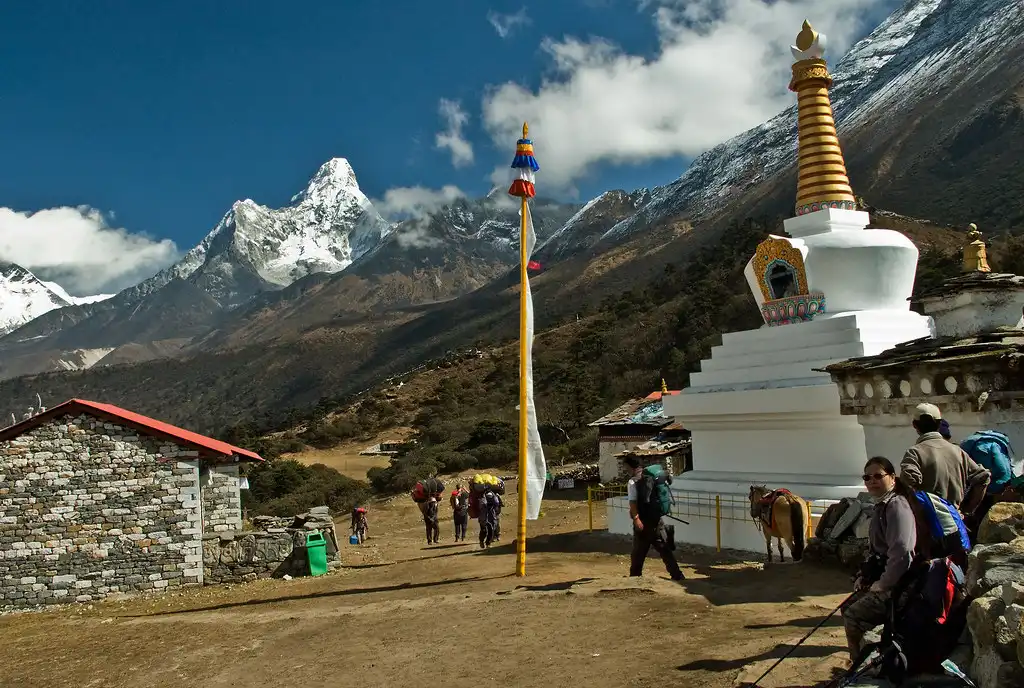
Arriving in Tengboche, you’ll be mesmerized by the beauty of its namesake monastery, a sacred sanctuary in the Everest region. Step into the peaceful atmosphere and join a guided tour, where the rhythmic chants of young Buddhist monks resonate through the ancient halls.
As the day winds down, take a moment to bask in the serenity and grandeur of your surroundings simply. The sight of Ama Dablam, often called one of the world’s most stunning mountains, will etch itself into your memory. Today is a blend of physical challenge and spiritual connection, a true highlight of your Everest Base Camp trek.
Accommodation: Local Lodge
Meals: Breakfast, Lunch, Dinner
Altitude: 4,400m/14,435ft Walking Distance: Approx 11km (6 hours)
After a hearty breakfast in Tengboche, your Everest Base Camp trek continues with a delightful morning stroll through vibrant rhododendron forests. Their colorful blossoms paint the landscape, and the crisp air and gentle path allow you to thoroughly soak in the surrounding natural beauty.
As you trek, you’ll encounter the Imja River, a mighty waterway born from the Imja glacial lake. A sturdy suspension bridge safely carries you across its rushing waters. From here, the trail unfolds before you, leading you almost directly to the welcoming village of Pangboche.
Take a moment to explore Pangboche, connect with the friendly Sherpa locals, and enjoy a well-deserved lunch. If you’re feeling adventurous, a hike to the ancient Pangboche monastery offers a fascinating glimpse into the region’s rich spiritual heritage.
The afternoon’s trek takes on a new character as the lush greenery fades into the stark beauty of the high-altitude desert. The trail becomes more demanding, winding through rocky terrain and revealing expansive vistas of the surrounding peaks.
Finally, you’ll arrive at your destination for the day: the picturesque village of Dingboche. Nestled amidst the arid landscape, Dingboche provides a haven to rest and recharge, preparing you for the next exciting chapter of your Everest Base Camp Trek.
Accommodation: Local Lodge
Meals: Breakfast, Lunch, Dinner
Altitude: 4,400m/14,435ft
This location is the final acclimatization stop before reaching Everest Base Camp. Use this occasion to explore the Chhukung and Imja glaciers and hike through the challenging Amphu Laptsa high passes. The natural splendor found in this area adds excitement to your adventure.
On your last resting day, allow yourself to be engrossed in the lifestyle of Sherpa people. Their warm welcomes and understanding of the Himalayan way of life will broaden your knowledge while making Cycling around Everest Base Camp much more enjoyable. Thus, getting involved with them makes it more personal.
Accommodation: Local Lodge
Meals: Breakfast, Lunch, Dinner
Altitude: 4,900m/16,076ft Walking Distance: Approx 11-12 km (6-7 hours)
As you leave Dingboche behind, the effects of the increasing altitude become more apparent on your Everest Base Camp Trek. The air thins and each step demands a little more effort. Pace yourself, take steady strides, and embrace the challenge as you trek towards Dungla.
Along the trail, you’ll encounter poignant memorials dedicated to the courageous climbers and trekkers who tragically lost their lives in the Everest region. These solemn tributes serve as a reminder of the mountain’s power and the importance of respecting its unforgiving nature.
Upon reaching Dungla, take a well-deserved break and refuel with a satisfying lunch. The views from here are already awe-inspiring, offering a glimpse of the grandeur that awaits.

In the afternoon, you’ll continue your ascent towards Lobuche, a small Sherpa settlement in the mountains. As you approach, prepare to be amazed by the panoramic views unfolding. Towering peaks like Mt. Lobuche, Mt. Pumori, and Nuptse dominate the skyline, creating a breathtaking backdrop for your arrival.
Settle into your accommodations in Lobuche and get ready for a chilly night at this high altitude. The crisp mountain air and the starry sky above create a magical atmosphere, reminding you of the extraordinary adventure you’re on.
Accommodation: Local Lodge
Meals: Breakfast, Lunch, Dinner
Altitude: 5180m/16,994ft (Gorekshep) & 5364m/17598 (EBC) Walking Distance: Approx 15km (6-8 hours)
Today marks the culmination of your Everest Base Camp Trek dreams – when you finally stand at the foot of the world’s highest peak. After a hearty breakfast, you’ll begin on a relatively gentle hike to Gorakshep, a rather barren yet fascinating expanse of a frozen lakebed covered with sand. This location is your last overnight stop before reaching the final destination.
The trail to Everest Base Camp from Gorakshep becomes steeper and windier, meandering through stony dunes and moraines – the ancient remains of glaciers. Although challenging, each step increases your anticipation as you reach that mythical summit.
Along the way, feast on the stunning Khumbu Glacier and be amazed by terrifying icefalls alternating with waterfalls tumbling down Everest slopes. You might even meet climbers preparing for their first summit attempt; their steadfast determination is genuinely motivating.
At Everest Base Camp, achieving an indescribable sense of accomplishment surpasses any other experience: you made it! Now it’s time to return home after lodges in Gorakshep, warm and hospitable places to seek out during chill nights on the trek.
As sunlight washes over other peaks around us, goodbye-golden the sun seems to say before setting, take some time and think about what has been unique about such an astonishing Nepalese tour through Mount Everest Base Camp Trek.
Accommodation: Local Lodge
Meals: Breakfast, Lunch, Dinner
Altitude: 5,545m/18,192ft (Kalapathar) & 4,320m/14,173ft (Pheriche) Walking distance: Approx 12-13km (5-6 hours)
Today starts before the first light paints the sky. With headlamps guiding your way, you’ll begin an early morning climb towards Kalapatthar, the “black rock” that promises a sunrise spectacle unlike any other. It’s an extraordinary moment on your Everest Base Camp Trek.
A breathtaking panorama unfolds as the sun’s first rays break through the darkness. Witness the majestic peaks of Nuptse, Changtse, and Lhotse bathed in the warm morning light, their snowy summits gleaming like jewels against the vast expanse of the sky. This unforgettable experience, a magical memory, will forever be etched in your heart.
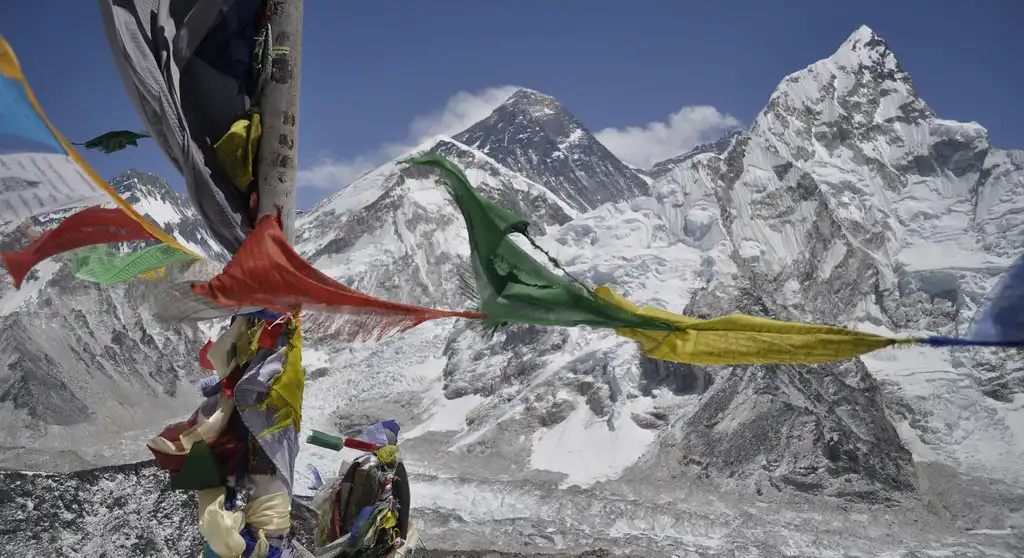
Kalapatthar also offers an unparalleled viewpoint for perfect photographs of Mount Everest, the massive structure looming over the skyline. Take your time to soak in the beauty, capture some great shots, and treasure them forever.
Once you’ve absorbed enough from this breathtaking view, it’s time to move back to Gorakshep for a well-deserved breakfast. After that, it will be time to return on the road to Pheriche.
The descent generally takes less time than climbing up; however, bear in mind distance and height. As you retrace your steps, expect rapid walking while admiring familiar sights from a new angle.
Remember to take a break when necessary and stay hydrated while relishing these last moments of your unforgettable trek through the Himalayas.
Accommodation: Local Lodge
Meals: Breakfast, Lunch, Dinner
Altitude: 3,440m/11,284ft Walking distance: Approx 13-15km (7-8 hours)
Once you have had a tasty breakfast to fuel you up in Pheriche, the day reveals itself with a journey primarily downhill back to Tengboche. This descent comes as a refreshing change of pace in your Everest Base Camp Trek because it allows you to admire the mountain scenery at a leisurely pace.
As you walk through this picturesque landscape, appreciate the magnificent peaks that have been your faithful friends throughout this fantastic trek. On arriving at Tengboche, delight yourself with a delicious lunch while enjoying your last minutes in this tranquil spiritual place.
From there, it continues to move downwards towards Namche Bazaar. The trail winds through beautiful Sherpa settlements and green woods, presenting an idyllic farewell view of the Himalayas. The evening finds you snugly seated in the wood fire warmth of your lodge at Namche town, pondering over all those great memories that made trekking memorable for life ever since day one.
Accommodation: Local Lodge
Meals: Breakfast, Lunch, Dinner
Altitude: 2,800m/9,184ft Walking Distance: Approx 16km (6-7 hours)
After breakfast, you start downhill and walk through the pine forest to Jorsalle. Cross the confluence of Dudh Koshi and Bhote Koshi rivers on a suspension Bridge, pass through beautiful settlements, circumambulate mani walls and walk along the Dudh Koshi river.
You reach Lukla in the evening to catch a flight the following day. Yes, you have done it. As this is your last night in the mountains, could you make the most of it?
Accommodation: Local Lodge
Meals: Breakfast, Lunch, Dinner
Altitude: 1350m/4428ft Flight time: 35 min
Post the last breakfast in the mountains and bid farewell to snowy summits as you take off from the Lukla airstrip en route to Kathmandu. Observing these aerial views provides an unforgettable glimpse of the Himalayas you have become accustomed to.
When you land in Kathmandu, our representative will greet you and ensure everything is smooth during the transfer to your hotel. The rest of the day belongs to you. You may explore ancient temples, get lost in bustling Thamel streets, or reflect on it all while enjoying yourself at the same time.
We’ll meet later for a special farewell dinner at a traditional Nepali restaurant where everyone will indulge themselves with delicious meals from their area and live performances from local dancers and musicians. And don’t forget about taking pictures or dance moves; this is all for celebrating how far you have come in life after finishing the Everest Base Camp trek and making new friends.
Accommodation: The Everest Hotel
Meals: Breakfast
We can get an occasional delay in flight during the primary season. The weather condition of Lukla suffers from quick changes, which may affect inbound and outbound flights, so we have reserved this day for other activities.
If we have a timely flight on DAY 14, we can use this day as rest or explore the day in Kathmandu. We can shop in and around local markets and plan a walk around the city.
Accommodation: The Everest Hotel
Meals: Breakfast
Altitude: 1,350m/4,428ft
Your last day in Nepal! Grab your breakfast and do some last-minute shopping. Nepali handicrafts can be beautiful souvenirs for your friends and family back home. Our representative will escort you to the Kathmandu International Airport 3 hours before your flight.
Hope to see you in Nepal again !!
Meals: Breakfast
The trek to Everest base camp is best done during spring (March to May) and autumn (September to November). These months have more stable weather, clear skies, and moderate temperatures suitable for trekking. Trekkers can also experience the additional beauty of blooming rhododendrons in spring, while autumn harbors clear mountain views after monsoon rains.
Venturing on the Everest Base Camp Trek during summer and winter off-seasons presents unique challenges. The summer monsoon (June to August) brings heavy rains, slippery trails, and potential leeches, making trekking more complex and less enjoyable.
Winter (December to February), on the other hand, offers fewer crowds but comes with harsh cold conditions, potential heavy snow, and closed sections of the trail, suitable only for the most experienced and well-prepared trekkers.
When deciding on the best time for your trek, consider how each season aligns with your preferences for weather, trail conditions, and crowding. Spring and autumn provide the best overall conditions for accessibility and enjoyment.
However, those looking for solitude and are prepared for the physical challenges may find the off-season’s quieter, more challenging conditions appealing. Always weigh the benefits of pleasant weather against the solitude of the less crowded months to choose the optimal time for your trekking experience.
Related Article: Best Time for Everest Base Camp Trek
The Everest Base Camp Trek presents a series of physical challenges that demand good preparation. Trekking very high up is dangerous, as you might get sick from the altitude and need a doctor quickly. Walking long distances daily over diverse landscapes in this track also takes a lot of muscle power.
Previous trekking experience and high physical fitness significantly enhance your ability to tackle the trek. The unpredictable weather and rigorous trail conditions call for trekkers to be in excellent health, with prior training in similar conditions being highly beneficial.
Building stamina through aerobic exercises and strengthening core and leg muscles are crucial for handling demanding trekking days.
To prepare for the Everest Base Camp trek, you must be physically fit and plan everything carefully. Let’s start conditioning exercises that include running and weightlifting before the last minute.
Besides, knowing about the trail itself, the acclimatization process and altitude sickness signs are vital things one needs to prepare for. Gradual ascents and days set aside for acclimatization will help you avoid the dangers of trekking at high altitudes.
Related Article: Everest Base Camp Trek Difficulty
The Everest Base Camp Trek is about 130 kilometers long, going there and back. It begins in Lukla and extends to Everest Base Camp, with trekkers typically covering between 10 and 15 kilometers daily.
The daily trekking duration can vary from 4 to 8 hours, depending on the terrain and individual pace. This extensive journey includes various stages, each with its challenges and scenery, ensuring the trek remains engaging and rewarding.
Proper pacing and acclimatization are crucial for successfully managing the physical demands of the trek. The itinerary usually includes several acclimatization stops, notably at Namche Bazaar and Dingboche, which are essential for adjusting to the high altitude.
Carefully planned acclimatization days help prevent altitude sickness and allow trekkers to enjoy the journey without undue strain.
Physical fitness and mental state are essential in preparing for the Everest Base Camp Trek. Cardiovascular exercises like jogging, hiking, or cycling can significantly enhance your stamina and endurance.
Strength training, especially leg and core workouts, is advisable to survive on rocky ground. Moreover, it is helpful to go up and down different terrains so that you will know how to cope with the hiking trail during the actual trek, which makes it easier and more exciting.
Related Article: Everest Base Camp Trek Distance
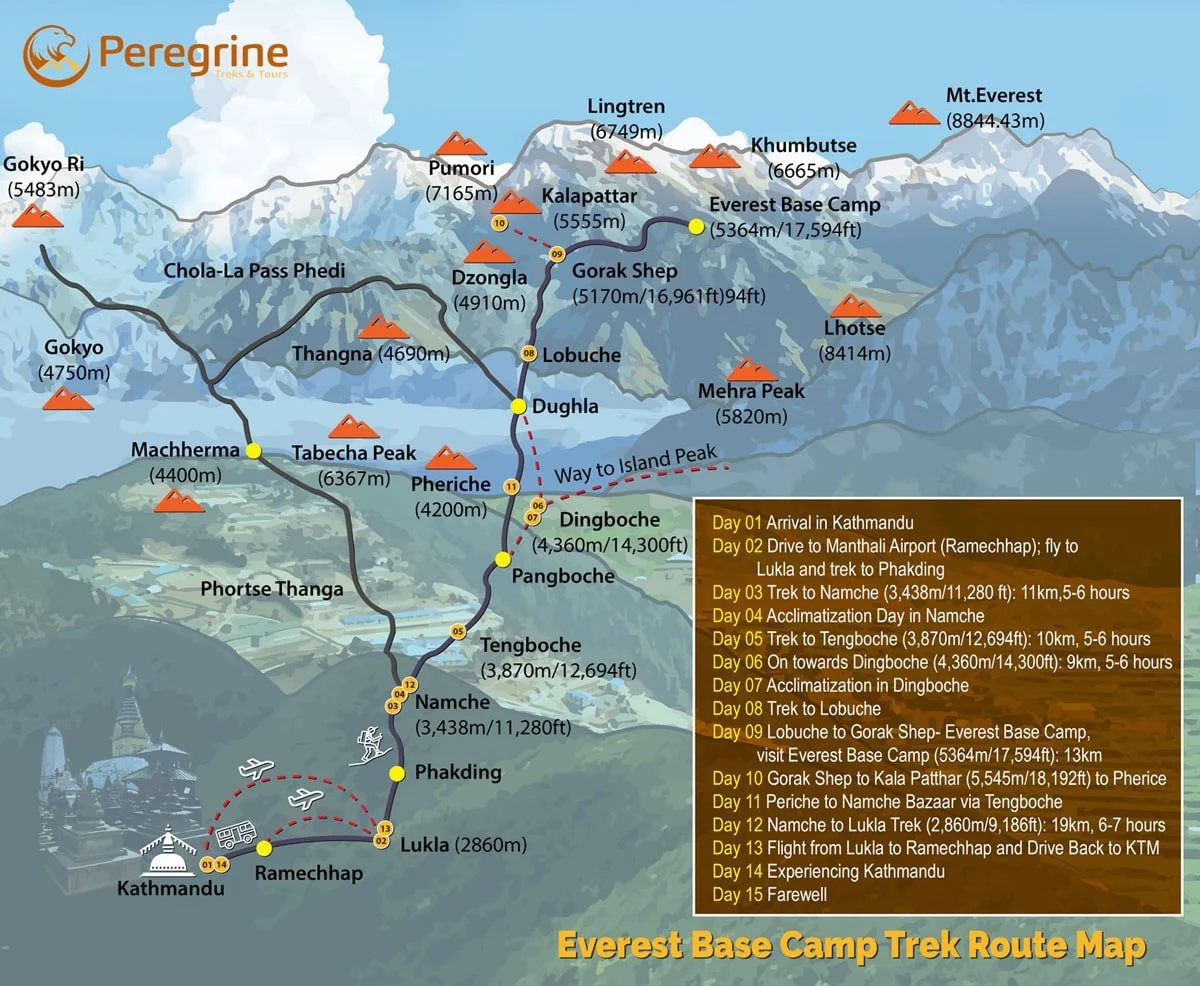
The Everest Base Camp Trek Map is vital for any trekker. It provides a detailed guide from Lukla to Everest Base Camp. The trek highlights critical stops like Namche Bazaar and Tengboche, among other essential acclimatization points. Knowing this route aids trekkers in preparing themselves both mentally and logistically for their trek by making them aware of the distances and elevation changes they will encounter every day.
It is necessary to have a comprehensive map and utilize appropriate navigational tools. The map takes trekkers through different trails or alternative routes, such as the Gokyo Lakes or the Three Passes Trek. It indicates crucial facilities like tea houses, clinics, and rescue stations. All these preparations contribute to safety and comfort and maximize the enjoyment of trekking experiences amidst the grand structures of the Himalayas.
Related Article: Everest Base Camp Trek Map
What can be more adventurous than trekking on Everest’s base camp, the highest mountain on earth? Everest Base camp trekking is among the best destinations for high-altitude lovers worldwide. The fantastic beauty of nature is reflected in the laps of high-altitude mountains. Rhododendron forests and hills are famous attractions for travelers.
The mesmerizing view of Mt. Lhotse, Mt. Nuptse, Mt. Amadablam, Mt. Pumori, and Mt. Thamserku can be observed on this trek. Everest base camp Trekking package lasts for 15 days or more. For further details, please feel free to inquire us. Various cultures, ethnicities, and spirituality are spread throughout Nepal.
The warm hospitality of the people in Nepal provides a fantastic feeling to the travellers, making an unforgettable experience for the trekkers. The poor, good-hearted Nepalese will benefit one way or the other from the expense of the trekkers. The journey to the Everest base camp begins from the capital city Kathmandu. Lukla, Namche Bazar is a lovely place to visit. The difference in the landscape and lifestyle of various areas within this small nation is beautiful. The Everest base camp trek is a perfect destination for trekkers.
Luxurious deluxe hotels are available in the capital city, Kathmandu, Lukla, and Namche Bazar, whereas comfortable local lodges are available on the trekking route. Hygienic food will be provided to the trekkers on the journey. The local foods and lifestyles of the people in these areas leave a sweet taste to the visitors.
To begin the trek, you must obtain permits and charges such as the entry fee to Sagarmatha National Park and local authority tax, which usually total approximately $42 per individual.
Flights between Kathmandu and Lukla constitute a significant part of the journey’s cost, priced at approximately $360 per person for a round trip. This fee includes all taxes but excludes airport transfers, which may cost around $15 one-way, depending on the distance of your hotel from the airport.
Lodging varies from simple teahouses to more luxurious lodges. Depending on the level of comfort and amenities offered, costs range from $10 to over $250 per night.
The cost of meals increases with altitude due to the logistics of transporting supplies. A typical day’s meal might cost between $35 and $40, with individual items like a pizza or a cup of coffee costing between $10 and $15.
You should hire a government-licensed guide, which costs about $25 to $30 daily, including food, accommodation, and insurance. You can hire porters for around $20 to $25 per day.
These may include gear rental, travel insurance, and personal expenses. Travel insurance, in particular, is highly advisable and can vary significantly in cost based on coverage and duration, generally starting from $200 to $600.
Related Article: Everest Base Camp Trek Cost
Loyal and experienced guides will accompany and provide necessary details throughout the trek. Altitude sickness is one of the general queries to any Trekker willing to go to the Everest base camp trek. Our guides will inform us about necessary precautions and acclimatization rules during the trip, and trekkers will be provided with essential medicines if needed. The trekkers should carry the required equipment along with them. Porters will be available for trekking if needed by the trekkers.
Related Article: Everest Base Camp Trek Preparation
The Everest Base Camp Trek is considered to be of a moderate to easy difficulty level. But to succeed on this expedition, you must be physically and psychologically fit. For this trek, your medical appearance should be excellent. Since there will be more elevation gain after Namche Bazaar, you should become ready to exert your endurance. It might not be appropriate for you if you have any lung-related health issues.
Furthermore, before going on a trek, doing cardiovascular exercise, stretching, and conditioning workouts will assist keep you upright on the trek. The ascent from Gorakshep will be tricky. The top of Kalapathhar also requires an elevation rise of about 200 meters from EBC. Therefore, Everest Base Camp Trekking requires the correct quantity of energy, often consuming food and drinks while on the trail.
Before the trek, you can also get some practice carrying backpacks and bags and hill running since you must have specific bag packs while on the trek; this will be a bit unconventional for you if you are a beginner. In addition, you may easily trek the Everest Base Camp if you are in good health and physical shape. Before Everest Base Camp Trekking, make sure to keep your physical and mental stability in better shape.
Related Article: Packing List for Everest Base Camp Trek
Every teahouse in the Everest region will have electricity and charging infrastructure. The availability of charging points is not a concern. Additionally, you can pack a power adaptor if there is no electricity at a higher altitude. Further, certain teahouses may impose a surcharge for charging approximately USD 1 or fewer services. Similarly, when it comes to electricity, inclement weather might occasionally cause an electrical outage in the Everest Region.
Purchasing travel insurance is a crucial decision to make while trekking to Everest Base Camp. Trekking beyond 5000 meters is somewhat hazardous; anything may happen. Therefore to address the main problem, you can get travel insurance if something unpleasant occurs. Don’t forget to purchase travel insurance with more than 5000m of altitude.
There won’t be any problems rescuing you if you have travel insurance. As part of the travel insurance, there will also be helicopter rescues. Also, our personnel will always be there to help you if any problems arise with your health or any natural disaster. To evacuate you from such a scenario, there will always be a rescue team and a rapid response technical team ready.
At an elevation of 5555 meters, the Kala Patthar summit is the highest point you will encounter. It is the viewpoint of Mount Everest. Trekker goes there for sunrise and sunset view. It would help if you trekked from Gorak Shep to reach there, and you could leave your trekking stuff there.
You can charge your electronic devices in the teahouse. Some teahouses might charge small amounts.
Yes, it would help if you had Sagarmatha (Everest) National Park Permit and Trekkers’ Information Trekking System (TIMS) card to trek Everest Base Camp. We will arrange such types of paperwork in advance. For this, we need your copy of your passport and PP-sized photographs.
To trek Kala Pathar from Gorakshep, there will be an additional 200 meters of ascent.
Of course, you can purchase antiques while on the trek.
You should carry woolen scarves, caps, gloves, insulated upper clothing, and snow-resistant jackets. Please email us at sales@peregrinetreks.com for a detailed packing list.
Other adjacent mountains you may see while trekking is Lhotse, Makalu, Kanchenjunga, Cho Oyu, Ama Dablam, and other Himalayas of Mahalangur Himalayan Range.
Including helicopter rescue and itinerary information in your travel insurance is possible.
Flights from Kathmandu to Lukla will take about 30 minutes. It is an adventurous flight in a small aircraft. There is a regular flight from Kathmandu, and we will try our best to provide the first or second flight. You need to book a package in advance to get earlier flights.
Trekking in the spring and autumn in the Everest region will make you feel immensely joyous.
Not at all places. We highly recommend you withdraw money from Kathmandu or Namche.
The sick trekker returned to Kathmandu, and the rest of members continue their trek.
Travel insurance is mandatory to travel with Peregrine Treks and Expedition. The insurance must cover accidents, medical, search and rescue insurance.
We can’t predict the weather in Lukla because it frequently changes. There are fewer chances to fly Lukla after the fourth round. If your flight cancels, we will try our best to provide an earlier flight for the next day. If you can’t continuously fly to Lukla, you must choose another similar package like Langtang Valley, Annapurna Base Camp, Annapurna Circuit, or Mardi Himal.

Based on 3 Reviews

Trekking up to Everest Base Camp was challenging, but it was much more satisfying and beyond my expectations. I communicated first-class with Pradip, who organized this EBC trek and Itinerary. I had an excellent trekking guide named Chetup, who looked after my ups and downs throughout the trek. He kept me informed about the Trekking distance to be covered, height to be ascended, and altitude to be reached daily, keeping me safe.
I will surely return to Nepal and have another adventure with Peregrine Trek. Namaste.
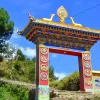
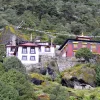
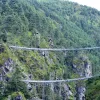
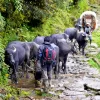

Excellent






Apart from arranging the entire Everest Base Camp Trek, Peregrine Trek made my emergency helicopter evacuation successful despite the busy trekking season. Before that, the trek was fantastic. The trekking guides handled us very carefully; nothing was too much trouble for them. They even offered to carry our hike bag pack when the going got too harsh. The porters were awesomely fantastic. Every food we had at our stop was just so delicious and energetic; I had no space left for the snacks I stocked up for hikes. At the office, Mr. Pradip was way too concerned and on time with us for our hotel transfers, airport pickup, and so on.
I highly recommend PEREGRINE TREKS as a trekking company. Client safety and satisfaction are their main priority. All the best, and we will return.

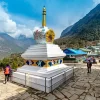

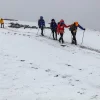

Excellent






We recently are back from completing one of the excellent treks in Nepal, the Everest Base camp Trek. Before the trek, I unfortunately suffered food poisoning in Kathmandu, but Peregrine treks were much of a help to rearrange everything and make our trip back on track. We started our trip, and on the first day, we acclimatized to Namche Bazar, where the accommodation and altitude were perfect. Our trekking guide and porter were brilliant on the EBC trek; we always felt safe and in good hands.
Pradip was a beneficial and easy-to-communicate guy at the Peregrine office. I recommend Peregrine Trek to everyone visiting Nepal for the excellent trek and pass on a helpful trekking review.

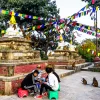

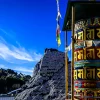

Very Good





